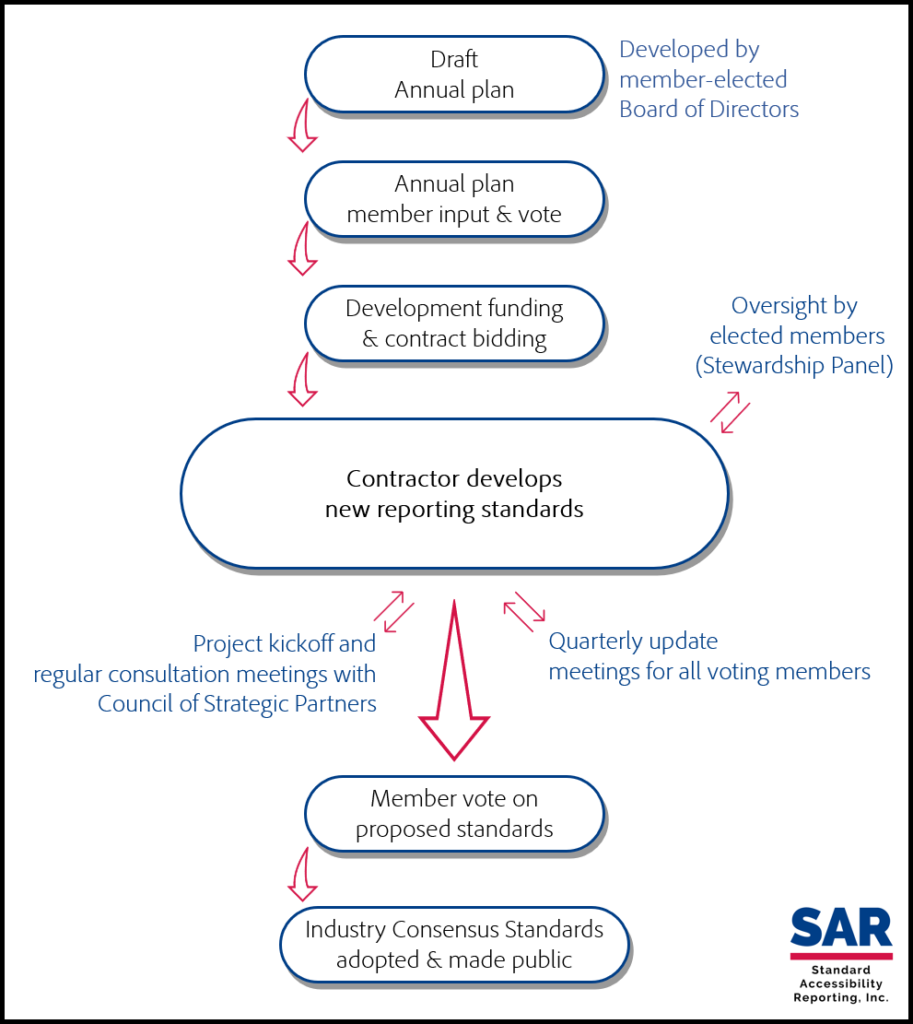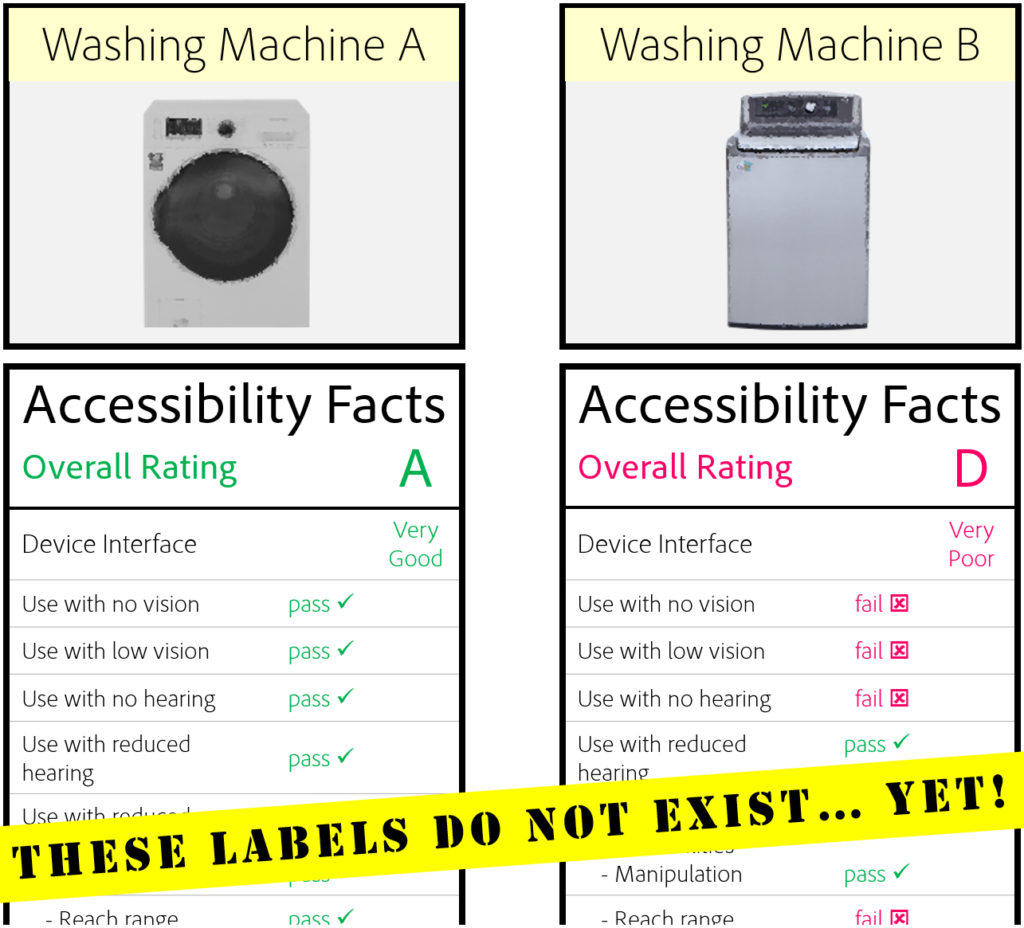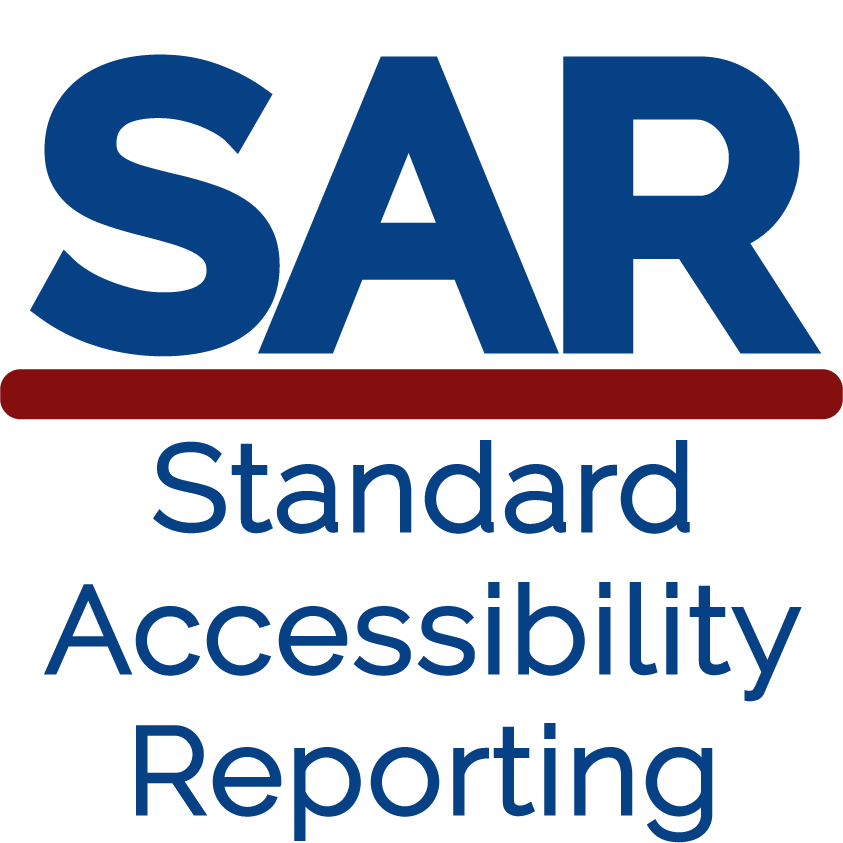Standards, testing, and reporting: the backbone of accessibility
How we develop standards (and why)
In order to have a uniform way to measure the accessibility of products and websites, we’ve developed a framework for evaluating products within a category.
The first part of this framework is made up of our X-step process for developing standards for assessing products in a given category. The second part is testing the products and, finally, gathering the test data and reporting the results.

At the center of our process are contractor developed accessibility reporting standards. Contractors are paid to fulfill a development process, and they must involve our members in the process. They do this by:
- Providing prototypes that members can try, examine, and provide feedback on
- Providing quarterly updates for all members on how they are meeting their contract, and answer questions from members that are posed at any time (via the appropriate committee chair)
- Having consultations with strategic partner members in regular meetings
- Adhering to the oversight direction provided by a committee of members who are paid
All of our voting members decide whether or not a proposed standard is adopted at the end of the development process.
All of our voting members provide input and vote on the adoption of our Annual Plan, which sets out which standards we will work on.
Our member dues cover the costs relating to the day-to-day running of the organization. Project Sponsors cover the costs of developing individual reporting standards.
Our members are not volunteers. We are not asking any member to give up their time and resources to develop standards. The benefits of the paid contractor model are that
- Others do the hardest part of the work, while members get to provide direction and feedback
- Standards are developed much more quickly than with volunteer-speed alternatives
- Developers are held accountable for delivering standards that are acceptable to the membership and their stated needs
Leadership is provided by a member-elected Board of Directors. Management of the organization is provided by a Board Appointed / Contracted Executive Director.
Our professional memberships are open to individuals and organizations who working on accessibility and technology.
Why are we developing these reporting standards?
For many reasons! Here are some of the main motivators behind our work:
The Market should not be this small
The consumer product marketplace is smaller than it should be

The accessibility testing field is growing; but the consumer product field needs a nudge in order to grow. Think about washing machines and other consumer household devices. They’re not accessible now, and so the accessibility testing field has an un-tapped market waiting for the right tipping point to come along.
One of our goals if to produce a standard test scoring system for consumer products, and to get mainstream technology review companies to adopt this system in their reporting. It won’t take too many ‘F’ ratings for manufacturers to seek advice on how to make their technologies accessible.
The website accessibility marketplace is smaller than it should be

If you work in the web accessibility field then you know about the annual WebAIM Million report. And you also know that this report tells us that just 3% of the world’s top websites can be considered “accessible”.
It’s not hard to determine that the internet is still fundamentally an un-tapped market.
One of our goals is to provide procurement officers the means to say “We want a web service provider who gets high standardized scores for accessibility that have been validated.” (Right now there is no standardized score and no standardized validation method for test processes. So we will make those happen.)
And we haven’t even mentioned Mobile Apps yet!
The Competition
How can you differentiate yourself from your competitors?
If all of the accessibility testing companies are using a different scoreboard, how can you declare yourself a winner?
How can you say with confidence that your test process is better than anyone else’s? How can your customers compare the scores you are giving them to the scores given by competitors? You are competing on quality and price, but nobody has a rulebook. Nobody really knows the score.
And why is this so important?
Not everyone is playing nicely
Some companies have bypassed the idea of quality (and truth and ethics) entirely, and are selling “the best”; “the fastest”‘; “the easiest” ways to “fix” accessibility. How do you prove this is just silicon snake oil without a standardized way to score how good a technology is in terms of accessibility. It’s just your word against theirs.
One of our goals is to create a standardized scoring system, developed by and voted on by industry consensus of those who have striven to provide true levels of accessibility for people with disabilities.
In Summary
Our standards development is member-directed, member-involved, member-overseen, and member-voted.
You can get all of the benefits of membership.
The reasons why we are doing this are to help people working in the accessibility and technology field solve some of their biggest problems and pain-points.
We have only touched on a couple of the main issues in this short article. If you have additional pain-points around accessibility testing, we can help.
Let’s start a discussion.
Standard Accessibility Reporting, Inc. is a nonprofit scientific, charitable organization formed in 2022.
